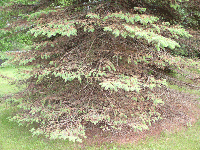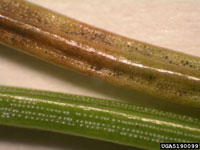Rhizosphaera kalkhoffii
Hosts
Spruce
Distribution and Disease Cycle

Photo credit: Joe Zeleznik and Kasia Kinzer, North Dakota State University
Rhizosphaera needlecast is a fungal disease affecting mainly Colorado spruce, and occasionally other spruce. The disease begins in the lower portion of the tree with infected needles being shed, causing branches to look sparse. Spore dispersal from infected needles occurs during wet weather in spring, spreading by rain from needles infected the previous season to newly emerging needles. Under suitable conditions, the disease gradually progresses up the tree continuing to cause loss of needles, leading to eventual decline of trees.
Symptoms and Signs

Photo credit: Michael Kangas, NDSU - North Dakota Forest Service, Bugwood.org
Symptoms of Rhizosphaera needlecast appear in the spring following infection, with infected inner (2nd year) needles turning yellow, then purplish-brown by end of summer, with black fruiting bodies appearing in lines as they emerge from needles' stomatal pores. Most infected needles will be shed by fall, although some may remain attached, acting as an infection source the following spring. Repeated infections will cause trees to begin having a sparse looking interior and after 3-4 years of severe infection, branches may begin to die.
Control
Management of Rhizosphaera needlecast can be difficult. To reduce the spread of Rhizosphaera needlecast, avoid pruning or shearing trees during wet weather and sterilize pruning tools frequently by dipping in 70% alcohol for 3 minutes. Remove any severely infected branches and rake fallen needles from the base of trees where practical. Promote good air circulation and encourage rapid drying of foliage by mowing weeds or other vegetation near trees. Chemical controls registered for Rhizosphaera needlecast control include fungicides containing chlorothalonil. Apply as per label instructions beginning in spring when new shoot growth is 1 to 5 centimetres in length, and again several times at 3-4 week intervals until conditions no longer favour disease development.